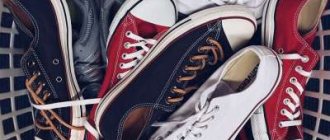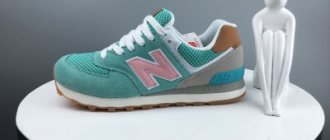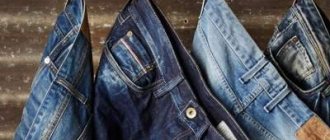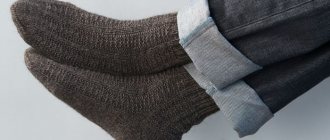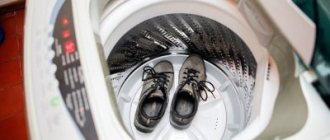Most modern people's wardrobes contain shirts. Men, children and women have this wardrobe item. It goes well with classic, casual and other styles.
In order for a shirt to look neat, you need to take care of it, including washing it correctly, taking into account the composition of the fabric and the features of the model.
How to wash men's and women's cotton, linen, synthetic shirts in an automatic washing machine and by hand, how to hang them correctly, how to dry them quickly, is it necessary to wash a new item before the first wear? Find answers to your questions in the article.
Preparation for the process
Washing in a washing machine is the simplest solution to the problem, but not every shirt can be subjected to such treatment. Improper washing can lead to damage to the item .
Basic information on washing can be obtained from the product label, which is located on the inside.
At the same stage of preparation, the product should be inspected. If there are defects, fix them first:
- sew on loose buttons;
- treat stains;
- sew up torn places, etc.
Hand washing rules
If delicate fabric was used to sew your item, then the label will definitely have a sign - a hand lowered into a basin. In this case, a manual water procedure will be necessary. To this end:
- fill the basin with lukewarm water,
- add washing powder,
- soak the item for twenty to thirty minutes,
- Carefully clean the dirty areas with your hands. You can use a soft bristle brush to
- problem areas are rubbed with laundry soap, left for about twenty minutes and washed again,
- rinse the product in cold water,
- The item is wrung out carefully, without twisting.
To bleach a shirt, you can add a non-chlorine bleach along with the powder.
Do you need soaking or not?
Pre-soaking before washing is often used when processing by hand. It is carried out in warm water in which washing powder or gel is carefully diluted.
Soaking allows you to:
- improve the quality of washing;
- extend the service life of the shirt.
The powder dissolved in water begins to act even before the main wash has begun - it allows you to better remove dirt, including on the collar and from sweat under the arms. Subsequently, even washing in a gentle mode will become much more effective.
You can soak a shirt not only in a solution of washing powder. Additionally, it is possible to use a stain remover or, in its absence, 1 tbsp. l. soda with 10 drops of ammonia.
This approach will prevent stains from being deeply absorbed into the fabric fibers and will make washing easier.
Removing traces of sweat in the armpit area
It is fair to say that this is a very complex matter. Quite often, almost new things are simply thrown away only because there are stains that are unpleasant to the eye. There are several ways to deal with this problem:
- Add 250 ml of vinegar to a bowl of hot water and soak the shirt for twenty minutes. Mix 200 g of soda and 10 g of salt. It is allowed to add 10 ml of hydrogen peroxide to this mixture. Having taken out the shirt, wring it out lightly and apply the prepared mixture to the problem areas. After waiting for about twenty minutes, the shirt is rinsed and washed using the approved method,
- Pour half a cup of vinegar into a liter of heated water. Soak the product in the solution for about forty minutes and rinse. If necessary, the procedure can be repeated. This method not only gets rid of stains, but also eliminates unpleasant odors,
- Lemons are known to everyone for their bleaching and disinfecting properties and environmental safety. Lemon juice is applied to the armpit area, after forty minutes the shirt is washed. There is another way to use this fruit - cut the lemon into slices, put it in a basin, add a spoonful of hydrogen peroxide, and pour in warm water. The shirt is soaked for one hour, then rinsed and washed.
How to wash in an automatic washing machine?
Washing shirts in a washing machine begins with sorting items by color and pre-treating stains . White and black items require separate processing.
If the material from which the product is made fades, then it is advisable to put such a thing in order only by hand.
At what temperature, in what mode?
For washing delicate fabrics, as well as those with inserts made of other materials, select the delicate mode. Durable cotton and linen models can be processed in the “cotton” mode, woolen ones – in the “wool” mode.
The choice of temperature regime is determined by the composition of the fabric . In most cases it should not be more than +40°C. For delicate fabrics - +30°C.
The manufacturer often allows white cotton shirts to be washed at a higher temperature. For people of color, the restrictions are stricter.
Detergent
A wide range of washing products gives you the opportunity to choose. It is better to give preference to those that come in gel form . They dissolve well. They are evenly distributed and do not form sediment.
Maximum load
When planning your wash, you need to consider the total weight of all the items that need to be placed in the drum in one load.
It should not exceed the maximum permissible for a specific model of washing machine. Shirts can be washed together with clothes of the same type that are suitable for the same cycle.
It can be:
- women's blouses;
- T-shirts;
- T-shirts, etc.
Which areas get polluted the fastest?
For sewing shirts, different fabrics are used, of which cotton always comes first. Fans of light, natural things like it.
Products made from viscose and cotton are easy to wash and iron. And they hold their original forms better, so water procedures do not greatly affect the quality of things.
Shirts made of silk and satin can attract consumers with their elegant appearance and lightness. But every item has problem areas - cuffs, collars, armpits, where dust, vehicle exhaust fumes, and sweat quickly settle. These areas are difficult to wash and require a special approach.
Manually
Hand washing shirts allows you to have complete control over the washing process. But this method is characterized by high labor costs.
Processing shirts by hand is indispensable in cases where you need to remove stains , or when it is necessary to process particularly delicate items.
At the same time, the choice of detergent, water temperature and spin capability are no less important than with automatic washing.
More details about the question can be found here.
Drying rules
The famous American shirt tailor Alexander Kabbaz advises drying shirts naturally and not in a dryer. However, you can still use this device, but you must select the No Heat option. Otherwise, you risk significantly reducing the life of the shirt. If you don't have a dryer, or if it doesn't have a No Heat option, you can hang your shirts on hangers—preferably plastic ones, not metal ones. Regular clothes dryers are also quite acceptable. In any case, avoid drying near a radiator or other heating devices.
Drying shirts on hangers
You should not unnecessarily dry it until it is completely dry: a shirt that is still slightly damp is easier to iron.
If the item has dried completely, you can sprinkle it with water and put it in a plastic bag so that it is evenly moistened. However, for some shirts this nuance does not matter - for example, for models made from non-iron or easy iron fabrics. They iron well in any case.
Do I need to wash a new one before wearing it for the first time?
The need to wash new clothes is a controversial issue. Many buyers are inclined to wash the shirt before putting it on for the first time.
During the production of clothing, its transportation and storage, it is exposed to chemicals, accumulates dust, and is touched by dozens of people. Despite the brightness of the colors and the freshness that is inherent in a new thing, it can be fraught with health hazards.
For shirts that have just been purchased, it is advisable to wash them in cool water . This can be done manually or using an automatic machine in a delicate mode without heating the water and strong spinning. Proper washing will not damage the new shirt.
Washing before the first wear will allow you to wash away any remaining dyes from the fabric, as well as substances that are often used to treat products - anti-caking, anti-mold, etc.
Rules for washing linen items
This case has its own characteristics. To begin with, select a suitable washing powder. Regular material is washed in simple powders, but for colored linen fabrics you will have to use compounds for fine materials that guarantee. That after the water procedure the shade of the product will not fade.
If your shirt has stubborn dirt or yellow discoloration, it is recommended to add a small amount of chlorine-free bleach to the water. Softeners should be used to wash bed linen.
Among other things, linen products shrink after washing. To avoid this, pay attention to quality when buying things. Quite often, when making such shirts, fabric with long fibers is used. Their surface is smoother, the weaving is durable, the color is deep - the product can last a long period. Many items undergo special treatment before sale, which prevents the items from shrinking.
It is prohibited to forcefully twist a shirt made of such material. It is lightly wrung out and straightened to give the desired shape. It is also prohibited to overdry the product. The shirt may lose its naturalness, a certain fragility will appear, and the fabric will begin to tear.
What does color affect?
Having sorted the shirts by color before washing, you need to decide on the choice of detergent and temperature:
For bright shades, high temperatures are undesirable, as they lead to color washing out. For colored products, universal products and those marked “Color” are suitable.- White shirts can also be washed with a similar gel or powder, but the best result will be achieved by using special detergents that are designed specifically for white clothes and contain bleach.
- For black shirts, a gel designed for washing black items is suitable. It will maintain the brightness of the coloring pigment and prevent it from washing out.
Ironing
Start ironing when the item is still slightly damp.
Ironed shirts
- If the shirt has had time to dry, use a spray bottle or sprayer, which is equipped with some irons.
- Iron on the reverse side only.
- Set the heating temperature of the iron (the desired level can be found on the label).
Advice! If there is no label, set the minimum heating temperature. If the blouse is not ironed, increase the temperature.
Fabric type
Shirts differ from each other in many ways:
- fabric structure;
- color spectrum;
- model;
- the presence of decorative elements;
- the presence of inserts from other types of fabrics, etc.
Taking into account the characteristics of each item, we select our own washing method, choice of mode and temperature.
Synthetics
Fully synthetic shirts are washed at a temperature not exceeding +50°C. For them, a choice of programs is possible in the washing machine:
- "delicate wash";
- "synthetics".
Denim material
Denim shirts should be washed separately from other clothing. This is due to fabric shedding.
For a denim shirt, choose a low temperature (no more than +40°C) . If the product has embroidery, appliqués or other decor, it is better not to machine wash it.
It is advisable to avoid exposure to aggressive detergents and abrasive surfaces (for example, rubbing with a brush), as the item may lose color.
Suitable automatic washing modes are:
- manual;
- delicate.
In this case, it is advisable to choose the minimum spin or completely abandon it. The denim shirt should be removed from the tumble dryer immediately after washing.
A short soaking of the shirt in cool water with the addition of vinegar (at the rate of 1 tbsp per 1 liter of water) will help preserve the shade of the material.
Cotton and linen
Shirts made from natural fabrics are prone to wrinkles. Taking this feature into account, it is advisable to set the spin cycle to minimum or turn it off. Otherwise, the products will be difficult to iron after drying.
The maximum temperature for washing cotton is +95°C . But such a choice can only be made for very dense white fabrics, which lack decorative elements, and for similar processing.
Colored natural fabrics are rarely washed at high temperatures, as this leads to discoloration of bright colors.
An unreasonably high washing temperature may cause the shirt to shrink.
Wool
Shirts made from wool are not common. If wool makes up more than 50% of the fabric composition, you should choose one of the modes:
- "delicate wash";
- "wool".
As with cotton and linen, exceeding the maximum permissible temperature can cause shrinkage and deformation of the item. It is advisable to exclude the spin cycle or set it to a minimum.
Stains are not a problem
Some stains are easy to remove. With others you have to tinker quite a bit. It all depends on their nature, as well as how long ago the clothes were soiled. But even the most difficult stains can be removed. To do this you need to know some tricks.
How to wash gouache on a white shirt
First of all, carefully examine the stain. If the gouache has already dried and lies in a thick layer, try to carefully clean it with a soft brush, being careful not to rub the paint into the fabric. Then place the stained area under running cold water. Some of the gouache will wash off from clothes on its own. Apply soap to the remaining stain - laundry soap or Antipyatin, an oxygen stain remover. Leave the soap for 20–30 minutes, the stain remover for 5 minutes. Wash the item in an acceptable way, choosing a temperature setting of 30 °C.
Attention! When removing gouache stains from a white shirt, only cold water should be used throughout the entire procedure! Otherwise, the paint may eat into the fabric.
How to wash blood
Blood is quite difficult to wash off, especially from white things. Wash clothes stained with blood only in cold water to avoid coagulation of the organic protein contained in the red cells.
A fresh stain can be removed using:
- laundry soap, rubbing it on a cloth soaked in water and rinsing under running cold water;
- crushed aspirin tablets mixed with water and applied to the blood stain until dry, and then washed off with cold water;
- table salt, poured onto a thing soaked in water and left until absorbed, then also removed with water.
Dried blood is much more difficult to remove. A stain remover such as Vanish can help. Apply a few drops of product to the stained area. Wait 3-5 minutes, then wash the product by hand in cool water with washing powder.
Another remedy for old blood stains is glycerin. Apply it warm to the stain. Leave it on all night. You can wash your shirt in the morning, preferably by hand.
Uniform, with shoulder straps
Uniform shirts can and should be washed regularly. But first, the shoulder straps are unfastened or paired, depending on their type.
The shirt is washed in the usual way, dried, and after ironing the shoulder straps are returned to their place.
If you leave the shoulder straps on the shirt while washing, then with a high degree of probability they will suffer and become deformed . At the same time, it will be almost impossible to return them to their original appearance.
In addition, there is a possibility that the elements of the shoulder straps can damage the drum and even lead to breakdown of the washing machine.
If you need to wash the shoulder straps themselves, it is recommended to use dry cleaning services . Or replace those that have lost their appearance with new ones.
Removing contaminants
On white shirts, some parts become dirty over time. Especially it concerns:
- a gate at which a yellow stripe appears at the break;
- cuffs, due to their frequent contact with various surfaces;
- armpit area where traces of sweat remain.
How to remove these contaminants?
How to remove yellow stripes from a man's shirt collar
Yellow streaks appear due to sebum and sweat remaining on the collar due to friction against the neck. Dirt and dust settle on them, penetrating deep into the fabric and eating into it. Ironing additionally “welds” the dirt. It becomes quite difficult to wash it off.
There are several most effective ways to get rid of the unpleasant yellow stripe on your collar:
- Laundry soap. Dip the collar in warm water. Apply soap to it thoroughly. Place the shirt in a plastic bag and leave for 1 hour. After the specified time, carefully rub the collar with your hands. If necessary, additionally carefully go over the collar with a soft brush. Rinse to remove all soap.
- Stain remover. Mix the product with a small amount of warm water. Finish the collar. After 5 minutes, rinse with cool water.
Advice! To remove a yellow stripe from the collar of a white shirt in the absence of a stain remover, you can use hair shampoo or dishwashing detergent, increasing the exposure time to half an hour.
After using one of the above methods, wash your shirt either by machine or by hand, depending on the type of fabric.
What to do if you sit down?
Washing your shirt incorrectly can cause the item to shrink. Most often, owners of shirts made from natural fabrics face this problem.
You can try to return things to their original size in several ways. Among the most popular options is soaking in solutions of hydrogen peroxide, alcohol, etc.
You can find out all the methods for stretching a shrunken shirt here.
How to dry it correctly and quickly, can it be hung on a rope?
Proper drying will allow you to spend less time on subsequent ironing. Damp fabric can easily become deformed and wrinkled.
To avoid possible mistakes, you should take into account the following recommendations:
The washed shirt must be immediately removed from the drum of the washing machine.- Hang the wet item on the trempel. It is advisable that the shirt does not touch other things during the drying process.
- Fasten all buttons if they were previously undone.
- Straighten the collar and other elements of the product before they dry. Pay attention to the cuffs and placket.
A completely wet item should not be ironed. Temperature changes and excess moisture can negatively affect the shirt.
How to rid a man's shirt of lipstick marks?
Before washing such stains, they are pre-treated. Please note that the lipstick remover is applied exclusively to the underside of the shirt in order to completely eliminate the risk of penetration and strengthening of fat cells into the tissue.
The following methods help best in such situations:
- a cotton pad is moistened with ammonia and the contaminated area is wiped. Movements are performed from the center of the spot to the edges. It will take several cotton pads until the lipstick disappears completely. Ammonia will give an unpleasant odor, but after the first wash it will completely disappear,
- Pour 3% hydrogen peroxide onto the stain, the lipstick mark will slowly begin to fade. The procedure is repeated until. Until the mark completely disappears. All that remains is to rinse the product and dry it.
Note that these methods help get rid of traces of oils and foundation.




